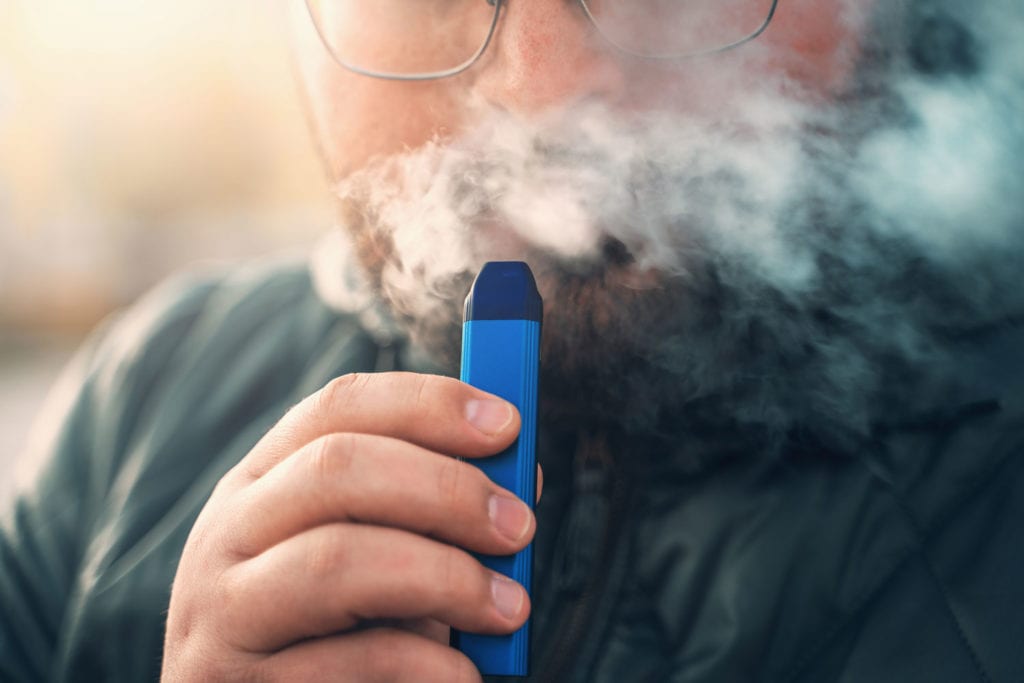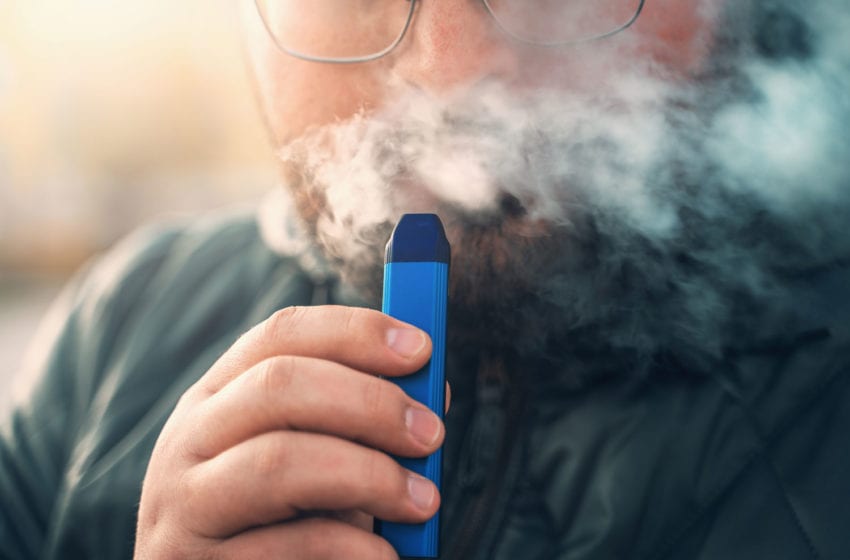
Current e-cigarette use in Great Britain has declined for the first time, most likely because of misinformation.
By George Gay
A number of countries are moving toward severely restricting the flavors that may be included in e-liquids, partly, they say, because certain flavors encourage vaping among young people—“young” being variously defined. Two of three countries that are going down this road and of which I am aware are, at the same time, moving toward bans on the sale of vapor products to young people, and one already has such a ban in place.
This means that, in these three countries (Denmark, the Netherlands and the U.S.), the proposed bans on generally popular flavors are aimed at discouraging adult consumers from attempting to switch from smoking to vaping and, given that nicotine users are addicted, encouraging vapers to switch back to smoking.
Nevertheless, these planned flavor bans are being put forward as health initiatives, so the only conclusion that can be drawn from what is going on in these countries is that those promoting the flavor bans believe that smoking is less risky than vaping.
How did they get to this point? Well, I think that we can rule out that they have been led there by scientists. While there seems to be a band of scientists desperate to prove that vaping is as risky, if not riskier, than smoking, I think I am on safe ground in saying that most scientists well versed in such matters will tell you that vaping is less risky—many would say hugely less risky—than smoking.
So if those promoting these flavor bans haven’t been led by the science, what has led them to this point? It can’t be politics because, in matters of public health, the politics would be guided by the need to protect people, which takes us back to the science. After all, what better proof could one have of this than the current situation where politicians are being led by the science in making decisions about fighting the coronavirus pandemic? Hmm.

Arbitrary choices
Perhaps it would be wise to take a closer look, and here I move the focus of the story from the three countries mentioned above to Great Britain. At the start of an opinion piece published in The Guardian in October, David Runciman, professor of politics at Cambridge University, quoted the German sociologist, Max Weber, as arguing a century ago that politics can never really follow the science. Later in the piece, Runciman wrote that “[i]n politics, expecting the evidence to point the way does not reduce the arbitrariness of the outcome.” He added that “all political choices are arbitrary to a degree. Using statistics to justify difficult decisions just makes them appear more arbitrary for anyone who happens to disagree.”
I can see what he is getting at, but this is not to say that politicians should flip a coin to decide policies, so I’m going to turn things around by using some statistics to challenge rather than justify what seem to me to be arbitrary decisions that are already on their way to being made in respect of e-liquid flavors. The reader will have to decide whether the statistics—evidence, science, call it what you will—make the decisions being taken more or less arbitrary.
The statistics have been taken from a recently published report, “Use of e-cigarettes (vapes) among adults [those over 18] in Great Britain,” which was based on data taken from an annual survey, “Smokefree GB,” carried out for Action on Smoking and Health (ASH) by the market research company YouGov. The survey started to include e-cigarette use in 2010, and the current update includes the results of the 2020 survey carried out in February and March.
These statistics concern Great Britain, which includes England, Scotland and Wales, but I imagine they would probably reflect, at least partly, the situation in many other countries.
Let’s start off by looking at what the point of vaping is, viewed solely from the point of view of the smoker and vaper. According to the report, “[a]s in previous years, the main reason given by ex-smokers for vaping is to help them quit (41 percent) and prevent relapse (20 percent)” while “[t]he main reason given by current smokers for vaping is to cut down (24 percent) followed by to help them quit (14 percent) and to prevent relapse (14 percent).” Moreover, the report says that when, in 2019, current vapers were asked about their views on vaping, most e-cigarette users said that improving their health was their number one reason for vaping. “Among all vapers, 60 percent agree that ‘health is my number one reason for taking up e-cigarettes,’” the report said.
It seems as though, under the current circumstances, these vapers and smokers are making rational decisions about their health, especially given that later in the report, it is noted that recent evidence from a randomized controlled trial showed that vaping was nearly twice as effective as nicotine-replacement therapy (NRT) in helping smokers quit in a Stop Smoking Service setting in England.
And if the focus is shifted from individual smokers to the wider population, it is worth noting that the report describes how the use of electronic cigarettes is largely confined to current and ex-smokers, with use among never-smokers remaining low, something, I think, that is suggested by the age profile of vapers. “The peak ages for current e-cigarette use in 2019 are among 35 [year-olds to] 44 year-olds (9.5 percent) followed by 45 [year-olds to] 54 year-olds (9.3 percent) and then 25 [year-olds to] 34 year-olds (7.8 percent),” the report says. “The lowest vaping rates by age are 4.3 percent for young adults aged 18 [to] 24 followed by those over 55 at 5.6 percent.”

Rational decisions
This all sounds very encouraging. Generally speaking, those who should have been taking up vaping—smokers—seem to have been doing so while those who shouldn’t have been—never-smokers—haven’t been. But there’s a fly in the ointment. The report says that for the first time (and at a time when there are still nearly 7 million smokers in the country), current e-cigarette use has declined year-on-year from 7.1 percent of the adult population in 2019 to 6.3 percent in 2020—from 3.6 million users to 3.2 million users.
Unfortunately, this is not surprising. “Misinformation continues to be a huge challenge for the [vapor] industry despite its efforts to make consumers aware of the evidence-based facts, including Public Health England’s statement that vaping is at least 95 percent less harmful than smoking,” said John Dunne, director-general of the U.K. Vaping Industry Association (UKVIA), in reacting to the report’s findings. “Inaccurate and misleading reporting, together with highly questionable research, gives a negative view of vaping to smokers who may otherwise quit. Even worse, it could make current vapers reconsider whether they’ve made the right move by taking up e-cigarettes.”
One result of the widespread dissemination of misinformation has been that the proportion of the adult population of Great Britain that thinks vaping is more or equally harmful than smoking is five times higher than it was in 2013, up from 7 percent in 2013 to 37 percent in 2020. But as the report suggests, the likely driver for the decline in e-cigarette use between 2019 and 2020 is the impact of the media coverage of an outbreak of serious lung injury among cannabis vapers in the U.S. “While the cause of this outbreak has since been identified as vitamin E acetate used to adulterate cannabis-containing e-liquids, the media coverage of the initial outbreak was far more prominent than the subsequent explanation or the fact that both vitamin E acetate and THC-containing liquids are banned under U.K. rules,” the report pointed out.
While some of those opposed to vaping might take comfort from the fact that fewer people correctly identify that vaping is less risky than smoking, they would be wise to hold the celebrations. The report points out, too, that only 34 percent of people correctly identified nicotine-replacement therapy as being much less harmful than smoking.

Additional discouragement
So what would happen if, on top of the above discouragements, the vaping environment was hit by significant reductions in the generally popular flavors that were allowed to be used in e-liquids? It seems to me that there would be two major effects—one of which would negatively affect vaping’s image.
The second major effect was described in the report itself. In 2019, the researchers asked current e-cigarette users what they would do if flavors were no longer available. “Around one in four said they would still try to get flavors, and just under one in 10 said they would make their own e-liquid,” the report said. “The most popular option after continuing to try to get flavors was using unflavored e-liquids/cartridges. However, just under one in five said that they would either smoke more or revert to smoking, and around the same proportion said that they did not know what they would do. Less than one in 10 said that they would stop vaping.”
There is some encouragement to be had from that last sentence, but I would worry that it masks some potential major problems. I would be concerned about where those replacement flavors would be sourced because we could be setting the seeds for a serious disease outbreak as happened in the U.S. in 2019. And the idea that people might be forced back to smoking is one that no responsible politician should contemplate. As the U.K. Member of Parliament (MP) Gareth Johnson, a member of the All-Party Parliamentary Group for Vaping, was quoted as saying in the UKVIA’s response to the report’s findings: “Vaping is significantly safer than smoking, and false information to the contrary is literally costing lives.”
What flavors are we talking about? In 2015, the researchers started asking e-cigarette users what flavor they used most often. At that time, tobacco was most popular (38 percent) followed by fruit flavor (25 percent) and menthol (19 percent). Now, fruit flavors are said to be the most popular (32 percent) followed by tobacco (23 percent) and menthol (22 percent). Very few users are using products with no flavors.
It cannot be denied that there is some conflict here given that fruit flavors are also the choice of many young vapers. One of the report’s references takes the reader to a 2019 report, “Use of e-cigarettes among young people [11–18] in Great Britain,” which states that the most frequently used e-cigarette flavorings for young people have consistently been fruit flavors, the choice of 45 percent of users in 2017, the last time this question was asked. But this has to be set against the fact that, with age restrictions in place, the number of young people vaping is low and should remain low no matter what flavors are available. Under their key findings, the researchers say that data from the 2019 ASH YouGov Smokefree youth GB survey suggest that while some young people, particularly those who have tried smoking, experiment with e-cigarettes, regular use remains low.
In fact, in reading the 2019 report, I was left with the feeling that young people are not particularly interested in e-cigarettes. I think this was summed up well in a section on brand awareness, which contained the comment, “Unsurprisingly, given the low levels of regular use, 55 percent of those who had ever tried e-cigarettes said they didn’t know what brand they used.”
Vaping seems to be approaching a watershed at which it cannot afford to be hit by further unnecessary setbacks, such as the withdrawal of some of the most popular e-liquid flavors. “There are still 3.2 million vapers out there who have made the successful switch, but there are also 6.9 million smokers—of which nearly a third have not tried vape products,” said Dunne. “These smokers can still turn to vaping to quit cigarettes and benefit from harm reduction.”












